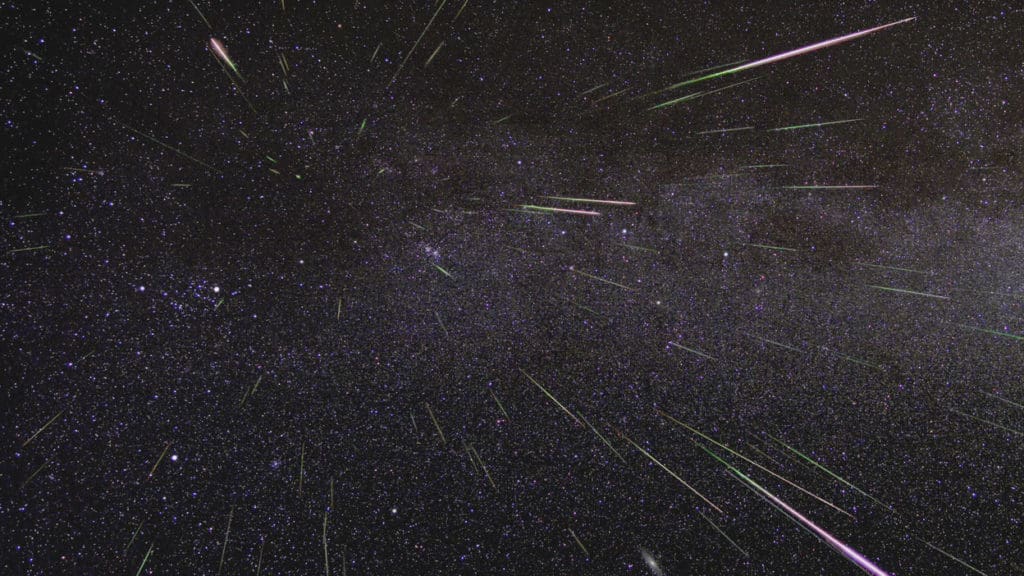Fire in the Sky
By Cosmic Strings In Cosmic StringsHave you ever seen a shooting star? Most of us have at one time or another. But did you know that mid-August is the best time of year to see shooting stars?
First of all, let me reassure you that the stars are not falling from the sky. A “shooting star” is actually a rock. From space! Bits of rock of all sizes pummel the Earth every day – we sweep up about 10 tons of material on a daily basis! Most of these rock pieces are so small that they are quickly destroyed by the friction they generate passing through our atmosphere – they disintegrate before we can even see them.
Some of these rocks from space (actually called meteoroids) can be pea-sized or larger, and those are large enough to generate enough heat as they pass through the atmosphere to make the air around them glow. That glowing air is what we see as a streak of light through the sky – a “shooting star” or a meteor.
When the rocks get really big, they can survive the passage through the air and some portion of them may hit the ground! Once they hit the Earth, the rocks are called meteorites. But remember, shooting stars happen very high in the atmosphere. Even if you see the streak, it is incredibly unlikely that you can find a meteorite. In fact, most meteorite experts agree that if someone comes in with a suspected meteor and they say they saw it fall, it is pretty much guaranteed not to be a meteorite.
Now as we said, rocks hit the Earth every day. So why is mid-August the best time to see meteors? Well, if you really want to see meteors, the best time to look is during a meteor shower, when the Earth is passing through a stream of debris left behind by a comet. The Earth does this fairly often too…but during the middle of August we pass through a really good one. The comet Swift-Tuttle leaves behind a lot of material as it passes, and the way the Earth moves through the debris is just perfect. Most meteor showers last a day or so, some only a few hours. But the meteor shower from Swift-Tuttle (called the Perseids because all the meteors look like they are coming from the constellation of Perseus the Hero) lasts for almost 2 weeks, with a good chance for meteor sightings each night. The shower generally peaks around August 12, meaning that this weekend is going to be prime time for meteor watching.


The August 2009 Perseid meteor shower is captured in this time-lapse image. Courtesy NASA/JPL.
The best way to watch for meteors? Set yourself up in a comfy chair. Bring some snacks and a drink or two. Be patient. Meteors rarely rain from the sky – on a good night of meteor watching you are lucky to see 5 or 6 meteors in a couple of hours. Try to be outside on the peak night of a meteor shower (August 12!) for your best chance. You don’t need binoculars or a telescope – you want to see as much of the sky as you can. Put any light sources at your back – and if you can, put the center of the meteor shower at your back too (the constellation Perseus in this case)! Remember, the meteors seem to be streaking away from the constellation at the center, so you want to be looking away from that area. Bring some friends – more people means watching more of the sky and a better chance to see a meteor! Best time to be outside? Sadly, like most things in astronomy, 2am is perfect. Thanks to the rotation of the Earth, at that time of the early morning, our own forward motion adds to the motion of the rocks and generally results in brighter meteors. But no worries – be outside at any time during the night to watch for meteors – you never know when you might see one!
If you want some company and lots of fun while you scan the skies, join us on Saturday, August 10! Come to the Virginia Living Museum during our regular operating day (9am to 5pm) for our Meet a Meteor event! We’ll have crafts, activities, games, some cool demos, and yes, a chance for you to touch a real meteorite! If you want to do some actual meteor watching, come back in the evening! Beginning at 6pm, we will be hosting our monthly Stargazing and Laser Light Night event. While the Sun is still shining, come grab dinner from Frank’s Monster Munchies Food Truck and the Wild Side Cafe, enjoy lawn games (Giant Jenga and Cornhole!) and live music in the garden. Get a preview of what’s happening in the sky in the Abbitt Planetarium with Virginia Skies at 6:30 or 7:30pm. We’ll begin setting up our telescopes around 8pm with an eye to beginning observing around 8:30-9pm. Laser shows also begin at 8:30pm and continue throughout the evening! Check out our laser show playlists online! Stargazing is FREE – planetarium and laser shows are $6 each or see any 2 shows for $10. Members are always half price! Don’t miss out on the fun!
See you Saturday,
Kelly






No Comment
Sorry, the comment form is closed at this time.